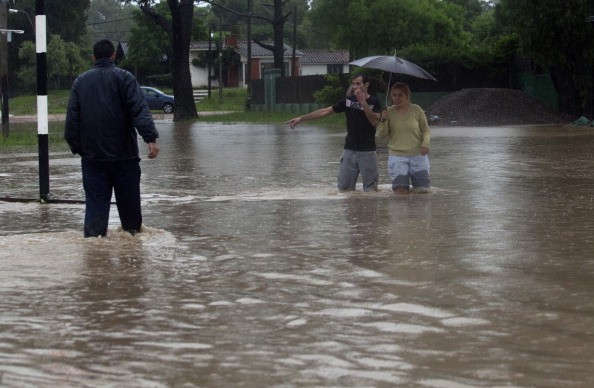The capital of Uruguay, Montevideo, was hit by a downpour at the beginning of the week, leaving streets submerged after more than one month's worth of rain impacted the area within a few hours.
The downpour began late Sunday night and continued until Monday morning, soaking the ground and pressuring storm drains.

Torrential Rainfall in Uruguay's Capital City
According to Accuweather, downtown Montevideo witnessed between 2 and 4 inches (50 and 100 mm) of rain, with Canelones, about 25 miles (40 kilometers) north, receiving up to 5 inches (120 mm).
Carrasco, a neighborhood on the east side of Montevideo, received the most rain, with 6 inches (147 mm) falling. For the most part, the rain fell in a two-hour period early Monday, according to Uruguay's meteorological office, Inumet.
For the whole month of January, the capital of Uruguay had an average of 2.90 inches (74 mm) of rain.
On Monday morning, residents woke up to see the city's streets flooded with cars and other debris after the severe rain, thunder, and lightning of the night before had not woken them up. The fast-moving floodwaters threw debris, including a dumpster, down a roadway.
At the National Firefighters Directorate, the phone lines were overwhelmed by simultaneous calls for assistance, according to the MercoPress news agency, which covers Latin America and the South Atlantic region.
Flooding After Heavy Rainfall
Nearly 150 requests for evacuation and 37 reports of downed trees had been received by the fire service before midday. Power interruptions affected around 12,000 people.
On Tuesday morning, the city of Montevideo's official Twitter account shared photos of delivery teams bringing beds and cleaning supplies to various parts of the city.
The extraordinary occurrence necessitated the use of all of the city's resources, according to officials. Debris piles on roads have been cleared by bulldozers.
A day after the heavy floods began, it was reported that no one has been killed or injured as a result of the incident.
The abnormally dry land caused by a prolonged drought undoubtedly contributed to the severity of the floods in addition to the intense rains. When the rain falls as swiftly as it did on Monday morning, the ground's ability to absorb water is reduced, resulting in more runoff.

More Torrential Rainfall May Worsen the Situation
In the past few weeks, South America has been struck by a series of extreme weather events, including a historic heat wave in Argentina, Uruguay, Brazil, and Paraguay and a tragic rockfall linked to heavy rain at a tourist site in southeastern Brazil.
Weather analysts predict that more rain could exacerbate the cleanup work in Montevideo and the neighboring areas.
Meteorologist Tony Zartman of AccuWeather says rain and thunderstorms will continue to move across the area for the rest of the week, and further amounts of 1-3 inches of rain, with locally higher amounts, are possible.
Zartman warned that even if the heaviest rains were to keep away from the places that had already been devastated by flooding, it would not take much rain to bring further flooding.
For more news, updates about torrential rainfall and similar topics don't forget to follow Nature World News!
© 2025 NatureWorldNews.com All rights reserved. Do not reproduce without permission.





